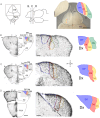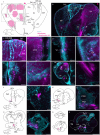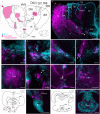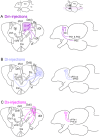Connectivity of a Conspicuous Layered Structure in the Dorsal Telencephalon of the Peacock Gudgeon, Tateurndina ocellicauda
- PMID: 40657851
- PMCID: PMC12258000
- DOI: 10.1002/cne.70064
Connectivity of a Conspicuous Layered Structure in the Dorsal Telencephalon of the Peacock Gudgeon, Tateurndina ocellicauda
Abstract
Within the mammalian pallium, layered structures, such as the six-layered isocortex and the three-layered hippocampal formation, are crucial for integrating sensory cues from the environment and for forming and recalling memories. Similar layered pallial systems have also been shown in avian and non-avian reptiles. Despite sharing similar needs for processing external information and remembering important sites, teleosts have generally not evolved such defined layered organizations in their dorsal telencephalon. One exception is gobiiform fishes in which a subregion of the dorsal telencephalon is organized into several fiber-rich and soma-dense layered subregions. We investigated the connectivity of these layered subregions (referred to as the dorsal telencephalic area X, Dx), as well as the connectivity of the medial (Dm) and dorsolateral (dDl) parts of the dorsal telencephalon through tracer injections. We found that extratelencephalic projections reach Dm, Dx, and dDl from different regions within the preglomerular complex (PG): Dm receives input from different PG regions: PG region 1 (PG1), PG region 2 (PG2), and the commissural PG (PGc), but not from the nucleus prethalamicus (PTh). In contrast, both Dx and dDl receive projections from the lateral PTh (PTh-l) and the medial PTh (PTh-m). We find that projections to dDl come from more ventral regions of PTh-m than those that project to Dx. The majority of ascending connections could be found within the telencephalon itself, with each of the telencephalic zones receiving its own distinct pattern of intratelencephalic afferent connectivity. From our results, we conclude that Dm and Dx constitute two distinct zones of the dorsal telencephalon.
Keywords: RRID:SCR_002285; RRID:SCR_013674; RRID:SCR_017641; ascending projections; neuronal layers; pallium; teleost; tract tracing.
© 2025 The Author(s). The Journal of Comparative Neurology published by Wiley Periodicals LLC.
Conflict of interest statement
The authors declare no conflicts of interest.
Figures







Similar articles
-
Short-Term Memory Impairment.2024 Jun 8. In: StatPearls [Internet]. Treasure Island (FL): StatPearls Publishing; 2025 Jan–. 2024 Jun 8. In: StatPearls [Internet]. Treasure Island (FL): StatPearls Publishing; 2025 Jan–. PMID: 31424720 Free Books & Documents.
-
Sexual Harassment and Prevention Training.2024 Mar 29. In: StatPearls [Internet]. Treasure Island (FL): StatPearls Publishing; 2025 Jan–. 2024 Mar 29. In: StatPearls [Internet]. Treasure Island (FL): StatPearls Publishing; 2025 Jan–. PMID: 36508513 Free Books & Documents.
-
The Black Book of Psychotropic Dosing and Monitoring.Psychopharmacol Bull. 2024 Jul 8;54(3):8-59. Psychopharmacol Bull. 2024. PMID: 38993656 Free PMC article. Review.
-
Cost-effectiveness of using prognostic information to select women with breast cancer for adjuvant systemic therapy.Health Technol Assess. 2006 Sep;10(34):iii-iv, ix-xi, 1-204. doi: 10.3310/hta10340. Health Technol Assess. 2006. PMID: 16959170
-
The Lived Experience of Autistic Adults in Employment: A Systematic Search and Synthesis.Autism Adulthood. 2024 Dec 2;6(4):495-509. doi: 10.1089/aut.2022.0114. eCollection 2024 Dec. Autism Adulthood. 2024. PMID: 40018061 Review.
References
-
- Broglio, C. , Rodríguez F., and Salas C.. 2003. “Spatial Cognition and Its Neural Basis in Teleost Fishes.” Fish and Fisheries 4, no. 3: 247–255. 10.1046/j.1467-2979.2003.00128.x. - DOI
-
- Campbell, C. B. G. , and Ebbesson S. O. E.. 1969. “The Optic System of a Teleost: Holocentrus Re‐Examined.” Brain Behavior and Evolution 2, no. 5–6: 415–430. 10.1159/000125898. - DOI
MeSH terms
Grants and funding
LinkOut - more resources
Full Text Sources

